The Acropolis of Athens Old Museum
IntroductionThe Museum existing until lately on the Acropolis rock was considered among the most important ones in the world and definitely the most important one as far as the History of European Art is concerned. It was built on the Acropolis Hill in 1874, in such a way that it would not aesthetically interfere with the Temples, nor be visible from anywhere within the city of Athens.
The excavations that followed, toward the end of the 19th century, unearthed a wealth of finds which were impossible to exhibit in the limited space of the Museum. Thus, the inscriptions, bronzes, clay objects, and a variety of other items were kept in the National Archaeological Museum, where they were originally taken for conservation. The situation was aggravated after all the marble pieces were removed from the Parthenon Friezes (that is, what was left over after Elgin's plunder) and were put in the museum, together with the Caryatids (the marble statues of the women supporting the roof of the south porch of the Erechtheion), all of which were removed to be kept in an air-tight window containing nitrogen, so as to stop air pollution from deteriorating the marble surfaces.
The collections of the museum included:
Sculptural offerings of the Archaic period
Pediments of temples dated to the Archaic period
Archaic Horsemen
Sculptures of the "Severe" style
Pediments and metopes from the Parthenon
The Parthenon frieze
The Erechtheion frieze
Parapets of the Athena Nike temple
Frieze of the Athena Nike temple
The Caryatids
Clay figurines and vases from the sanctuary of the Nymphs.
Everyone was eagerly anticipating the completion of the new Acropolis Museum, for the total wealth of finds related to the Acropolis and the Parthenon to finally be exhibited in the best possible way (combining location, lighting, space, air filtering and thematic consistency), and thus deprive the descendants of Lord Elgin of all plausible excuses to insist that the Parthenon Marbles continue to be kept separated from the rest of their like and the Parthenon remain in its mutilated state.
During 2008, the exhibits of this Museun were transferred to the New Museum, the erection of which was completed. Three huge cranes were used to carry all the heavy marble statues and exhibits, a total of some 4,500 artifacts from the old, cramped Acropolis museum, a task that was the biggest airlift of antiquities in Greek history. It was the first time the artifacts — some of which are considered among the most important works of antiquity — were moved from the very Acropolis Rock. This transfer was completed in the end of spring but putting up the exhibits in their right place would take a lot longer.
We thought that the present Album would become useless after the New Museum's inauguration. Nevertheless, the decision of the museum authorities to prohibit taking photographs of the exhibits in their new surrounding created more problems than the ones it was supposed to solve. We admit that the decision was well meant, but, with all due respect, we would like to point out that times have changed; we are afraid that whatever is not shown online cannot achieve the level of promotion that it may be worthy of. We managed, though, to get a number of photos of the exhibits, as the decision was taken a couple of weeks after the museum's inauguration. We are working on them and will do our best to put them up as soon as possible. But, in our effort to best present the exhibits, we are sorry to have to use some of the photos taken at the Old Acropolis Museum. Until the New Acropolis Museum album is online, please enjoy the marvellous artifacts at their old "home".
(Photos: Michael Tziotis)
Select Page of the Album:
Click on any of the pictures to enlarge.
Gallery IV: The Korai
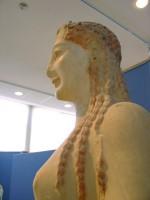
Akr 679. “The Peplos Kore”
One of the most exquisite of the Acropolis Korai, her slightly-built form is endowed with grace. She wears a simple Doric peplos after which she was named. Her left arm was separately attached. Her sweet face is enlivened by the color of her eyes and hair which falls in tresses on her back and chest. The drill holes in her ears indicate that she wore metal earrings; she also had a painted necklace. Multicolored patterns adorn her garment. The work of an excellent sculptor, made of Parian marble around 530 B.C. |
|
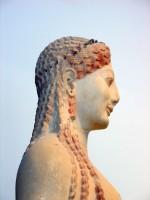
Akr 679. “The Peplos Kore” Profile |
|
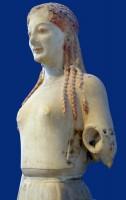
Akr 679. “The Peplos Kore” |
|
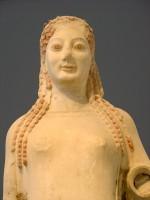
Akr 679. The “Peplos Kore” (Bust) |
|
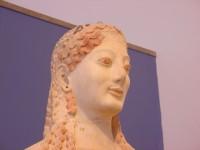
Akr 679. The “Peplos Kore” (Portrait) |
|
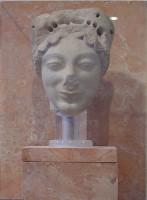
Akr 643. Head of a Kore
Head of a Kore made of Parian marble. The upper part is an added piece of Pentelic marble. Nine large holes above her forehead held metal ornaments; ornaments were also set into the diadem. The face with its half-closed eyes and subtle smile gives the most sublime expression of refined vitality. Around 510 B.C. |
|
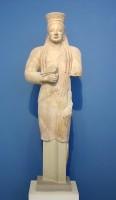
Akr 269. The “Lyons Kore”
Holding a dove at her breast; her right hand rested on her thigh. Her powerful arms and broad shoulders are in contrast to her slender waist. This is the first example of an Attic Kore in Iomic costume, namely chiton and slanting himation. On her head she wears polos (hair dress) with painted palmettes and lotus flowers and her earrings are in relief. The upper part is a plaster cast taken from the original naw in Lyons, France. Dated to 550-540 B.C. |
|
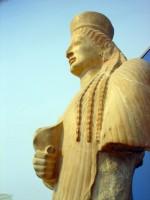
Akr 269. The “Lyons Kore” |
|
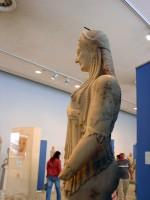
Akr 662. Statue of a Kore
Statue of a Kore made of island marble. This Kore, taller than the others, with sumptuous painted ornamentation and a sophisticated coiffure, reveals strong Ionic influence. The slanting eyes, long nose and small mouth give her an air of haughty femininity. The inlaid eyes were made of another material. Around 525 B.C. |
|
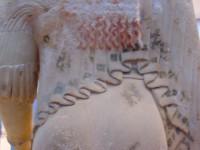
Akr 662. Statue of a Kore (Detail of her Back) |
|
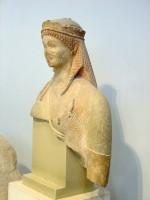
Akr 669. Kore of Island Marble
The figure is peculiar in that whereas the head has early stylistic features (such as the wig-like hair, dull shallowly carved ears), the free rendering of the drapery folds shows that this is a later work with a tendency to archaism. Akr 669a, the lower part of a statue, most probably belongs to this Kore. Around 530 B.C. |
|
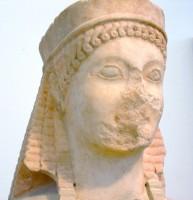
Akr 669. Kore of Island Marble (Portrait) |
|
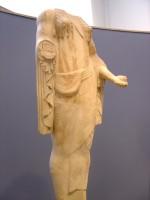
Akr 615. Statue of a Kore
She is holding out gifts to the goddess with both her hands. She wears chiton, himation and epiblema, but her garments are not richly pleated like those of the other Korai. The pulled out pocket at the right hip is a new feature and many other new elements, such as the naturalistic rendering of the tresses and the contours of the body, herald the spirit of the Severe Style. Made of island marble around 500 B.C. |
|
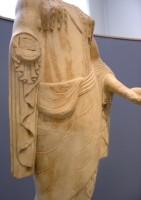
Akr 615. Statue of a Kore (Close up) |
|

Akr 670. Statue of a Kore
Statue of a Kore of island marble. Her chiton, painted with rosettes, falls loosely over the upper part of the body. The way in which her left hand bunches up her garment in front, so that it falls straight down in folds, is extremely unusual in Attic sculpture. She wears a painted diadem and there is a bracelet on her left arm. The right forearm was separately attached and she would have held an offering in her right hand. About 520-510 B.C. |
|
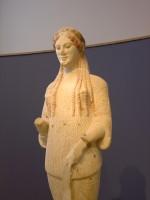
Akr 670. Statue of a Kore |
|
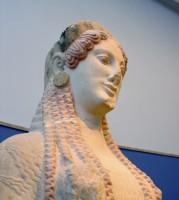
Akr 670. Statue of a Kore (Bust) |
|
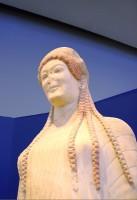
Akr 671. Statue of a tall straight Kore
Pentelic marble statue of a tall straight Kore, simply clad, the folds of her garments not elaborately rendered. The delicate ripples in the chiton enliven the composition. Wavy hair over the forehead and coils at the temples frame her charming features. She wears a diadem and had bronze earrings, now missing. The right arm was separately attached and she would have held an offering in her right hand. Around 520 B.C. |
|
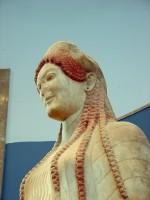
Akr 671. Statue of a tall straight Kore (Bust) |
|
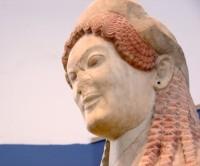
Akr 671. Statue of a tall straight Kore (Portrait) |
|
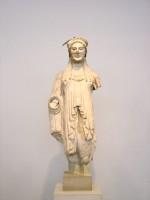
Akr 673. The Kore with the Disc-shaped Earrings
Statue of a Kore with much of her legs and arms missing. She wears a chiton and an himation falling from her shoulders in heavy vertical folds. Her large-boned fleshy face is framed by snail-shell curls. She wears disk shaped earrings and a diadem with painted meander pattern. The borders of her garments are decorated with multicolored patterns. The metal meniskos on her head has been preserved bent out of shape to the right. 520-510 B.C. |
|
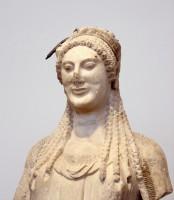
Akr 673. The Kore with the Disc-shaped Earrings |
|
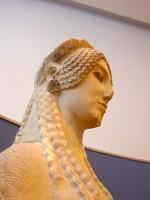
Akr 674. The “Sphinx-eyed Kore” (Portrait) |
|
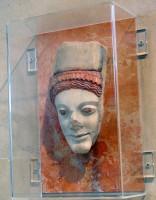
Akr 696. The “Polos Kore”
The face of a Kore wearing a high polos (hairdress). Tke lively color of her hair waved over her forehead and the painted pupils of her eyes bring out the paleness of her skin. The sweeping curves of her brows and the expressiveness of the mouth impart an impression of inner life. Fragments of the body of the Kore are also preserved. Around 500 B.C.
|
|
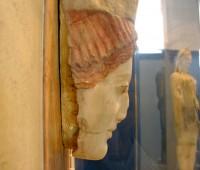
Akr 696. The “Polos Kore” Profile |
|
|
Select Page of the Album:
|
|



